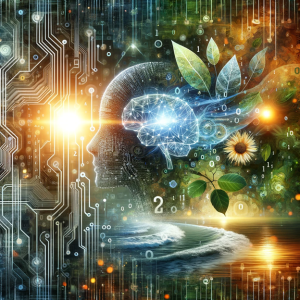
AI for a Greener Future: Balancing Technological Advancement and Environmental Sustainability
In the rapidly evolving technological landscape of today, Artificial Intelligence (AI) stands out as a central theme, particularly in the context of environmental sustainability. AI's capabilities in enhancing efficiency, minimizing waste, and fostering innovation make it a pivotal tool in addressing environmental challenges and steering us towards a more sustainable future. This is a key aspect of AI for Environmental Sustainability. However, it's crucial to be mindful of AI's potential risks and challenges, ensuring its use in a responsible and ethical manner. AI's role in improving energy efficiency in buildings and industries is significant. By predicting energy usage patterns and optimizing consumption, AI can identify areas of energy waste and suggest ways to reduce it. For instance, Google's DeepMind has utilized AI to optimize cooling systems in data centers, reducing energy consumption and carbon emissions. Similarly, Tesla employs AI in its electric vehicles for autonomous driving features, optimizing driving patterns for increased energy efficiency and reduced emissions. In the realm of renewable energy, AI aids in the development of sources like wind and solar power. It predicts energy output, optimizes performance, and improves maintenance. GE Renewable Energy's use of AI in wind turbines is a prime example. These turbines are equipped with sensors and AI algorithms that adjust operations based on wind condition predictions. This not only optimizes energy output but also ensures maximum efficiency. Furthermore, AI-driven maintenance scheduling proactively identifies and addresses issues, reducing downtime and maintenance costs. Such applications of AI are pivotal for the growth and efficiency of renewable energy. AI also plays a crucial role in creating smarter energy grids. By analyzing data from sensors, meters, and other devices, it enables utilities to better manage electricity supply and demand, reduce energy waste, and improve reliability. Microsoft, for example, uses AI to enhance energy efficiency in its data centers and aims to be carbon negative by 2030. In sustainable agriculture, AI assists in analyzing soil data, predicting crop yields, and identifying pest and disease outbreaks. This helps farmers optimize crop production while minimizing the use of pesticides and fertilizers. Companies like Farm wise leverage AI-powered robots for precise weed removal, reducing the need for chemical herbicides and promoting sustainable farming practices. AI's role extends to waste management as well, where it improves systems by analyzing data on waste production, collection, and disposal. This enables cities and municipalities to optimize waste management systems, reduce waste, and increase recycling rates. Waste Robotics, for instance, employs AI-powered robots to sort recyclable materials, enhancing recycling efficiency and reducing landfill waste. In water management, AI studies data on usage, quality, and availability, aiding cities and municipalities in better managing water resources, reducing waste, and improving quality. Organizations like Ocean Cleanup deploy AI-powered systems for tracking and collecting plastic waste in oceans, contributing significantly to marine environment cleanup efforts.
AI's contributions to addressing climate change are notable. By examining data on greenhouse gas emissions, weather patterns, and other environmental factors, AI informs policies and strategies for reducing emissions and mitigating climate change impacts. IBM’s Watson, for instance, aids in understanding and predicting weather patterns and climate change impacts through various applications, including weather forecasting and climate modeling. For biodiversity conservation, AI investigates data on species populations, habitats, and threats. This informs conservation strategies and enhances understanding of the complex relationships between species and their environments. Conservation International uses AI to analyze biodiversity data and track ecosystem changes, playing a crucial role in the protection of natural habitats. AI's significant role in achieving the Sustainable Development Goals (SDGs) adopted by the United Nations in 2015 cannot be overstated. The SDGs aim to end poverty, protect the planet, and ensure prosperity for all. AI aids in these goals by improving efficiency, reducing waste, and promoting innovation across sectors. It improves access to healthcare and education, reduces poverty, promotes economic growth, and aids in achieving environmental goals like reducing greenhouse gas emissions, conserving biodiversity, and promoting sustainable natural resource use. However, the adoption of AI must be managed carefully to avoid negative impacts on sustainable development. This requires ensuring ethical and responsible AI use, protecting privacy and security, and extending benefits to all, including marginalized communities. Energy consumption by AI systems is a concern, as these systems demand substantial energy for operation and training, contributing to greenhouse gas emissions. Balancing AI's growth with environmental sustainability is essential. Additionally, AI development contributes to electronic waste, which can have harmful environmental impacts. To minimize e-waste, AI hardware and components must be designed for durability, repairability, and recyclability. AI systems can also perpetuate bias and discrimination if trained on biased or incomplete data, leading to negative social and environmental impacts. Privacy and security are other concerns, as AI often relies on personal data. Inappropriate use can compromise individual privacy and security, negatively impacting social and environmental well-being. Job displacement due to AI, particularly in industries like manufacturing and transportation, can have negative social and economic impacts, especially in communities reliant on these industries. Moreover, growing dependence on AI technology may reduce human interaction with the natural environment and contribute to social isolation, hindering our ability to create sustainable and inclusive communities.
